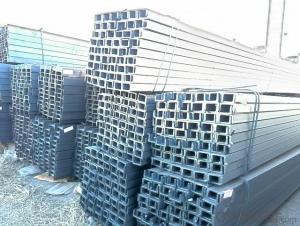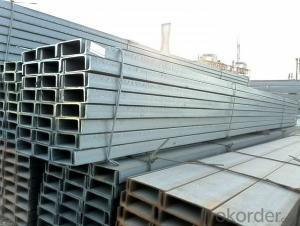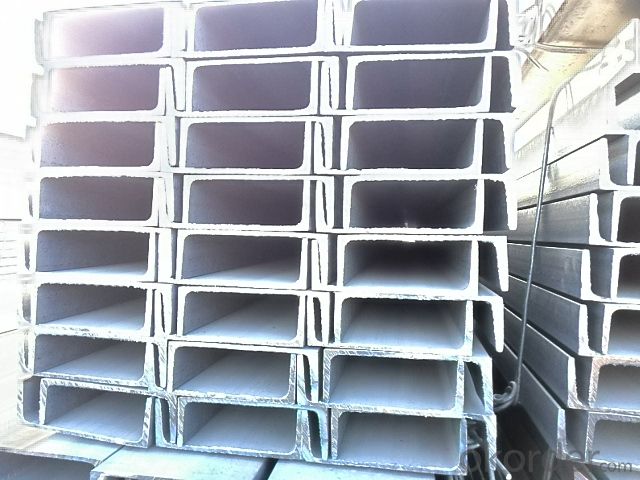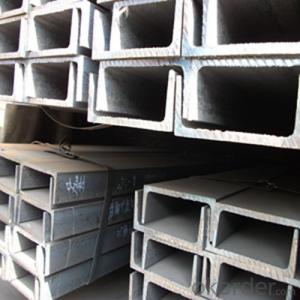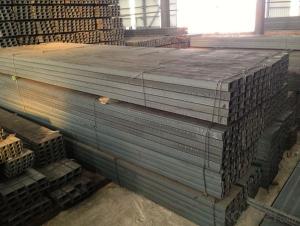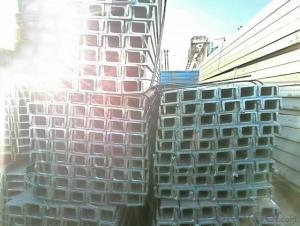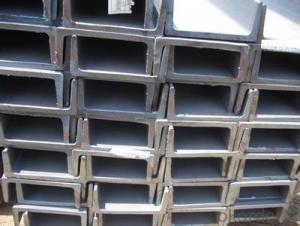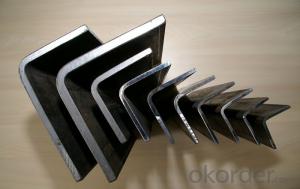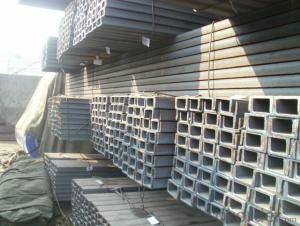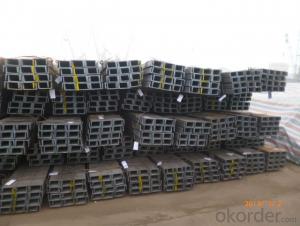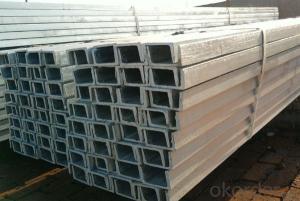JIS U Channels with High Quality and Competitive Price
- Loading Port:
- Tianjin
- Payment Terms:
- TT OR LC
- Min Order Qty:
- 25 m.t
- Supply Capability:
- 10000 m.t/month
OKorder Service Pledge
OKorder Financial Service
You Might Also Like
Product Description:
| Minimum Order Quantity: | 25MT | Unit: | m.t. | Loading Port: | Xingang Port |
| Supply Ability: | 120000TON/Year | Payment Terms: | TT or LC |
Product Applications:
Japanese Standard U-channels are ideal for structural applications and are widely used in the construction of buildings and bridges, and the manufacturing, petrochemical, and transportation industries.
Product Advantages:
OKorder's Japanese Standard U-channels are durable, strong, and resist corrosion.
Main Product Features:
· Premium quality
· Prompt delivery & seaworthy packing (30 days after receiving deposit)
· Corrosion resistance
· Can be recycled and reused
· Mill test certification
· Professional Service
· Competitive pricing
Product Specifications:
Manufacture: Hot rolled
Grade: Q195 – 235
Certificates: ISO, SGS, BV, CIQ
Length: 6m – 12m, as per customer request
Packaging: Export packing, nude packing, bundled
1. We are definitely speciallizing in manufacturing and supplying channel steel as per japanese standard, which is characterised with high mechanical strength and competitive prices.
Original Place | Tangshan, China | Brand Name | UINDA |
Standard | JIS G3192 : 1990 | ||
Material Grade | SS490 | ||
Sizes | 50mm to 200mm | ||
Sales Volume/Year | 3000MT | ||
Destination Area | Middle East, Africa, Southeast Asia | ||
2. The sections in details are as followings in the table-1
JIS U CHANNEL | Standard | Sectional | Dimension |
| Mass: |
| (mm) | (mm) | (mm) | (mm) |
|
50x25 | 50 | 25 | 3.0 | 6.00 | 2.37 |
75X40 | 75 | 40 | 3.8 | 7.00 | 5.30 |
75X40 | 75 | 40 | 4.0 | 7.00 | 5.60 |
75X40 | 75 | 40 | 4.5 | 7.00 | 5.85 |
75X40 | 75 | 40 | 5.0 | 7.00 | 6.92 |
|
|
|
|
|
|
100X50 | 100 | 50 | 3.8 | 6.00 | 7.30 |
100X50 | 100 | 50 | 4.2 | 6.00 | 8.03 |
100X50 | 100 | 50 | 4.5 | 7.50 | 8.97 |
100X50 | 100 | 50 | 5.0 | 7.50 | 9.36 |
|
|
|
|
|
|
125X65 | 125 | 65 | 5.2 | 6.80 | 11.66 |
125X65 | 125 | 65 | 5.3 | 6.80 | 12.17 |
125X65 | 125 | 65 | 5.5 | 8.00 | 12.91 |
125X65 | 125 | 65 | 6.0 | 8.00 | 13.40 |
|
|
|
|
|
|
150x75 | 150 | 75 | 5.5 | 7.30 | 14.66 |
150x75 | 150 | 75 | 5.7 | 10.00 | 16.71 |
150x75 | 150 | 75 | 6.0 | 10.00 | 17.90 |
150x75 | 150 | 75 | 6.5 | 10.00 | 18.60 |
150x75 | 150 | 75 | 6.5 | 10.00 | 24.00 |
|
|
|
|
|
|
200X80 | 200 | 80 | 7.5 | 11.00 | 24.60 |
Table-1
3. The mechanical property of JIS U Channel Steel in the table-2:
Grade | Yield Strength,N/mm² | Extension Strength N/mm² | |||
Thickness of Steel,mm | |||||
≦16 | >16-≦40 | >40-≦100 | >100 | ||
SS490 | ≧285 | ≧275 | ≧255 | ≧245 | 490-610 |
Table-2
4. The chemical composition of JIS U Channel Steel as per SS490 in the table-3
Grade | Element(%) | |||
C | Mn | P | S | |
SS490 | - | - | ≦0.050 | ≦0.050 |
Table-3
FAQ:
Q1: Why buy Materials & Equipment from OKorder.com?
A1: All products offered byOKorder.com are carefully selected from China's most reliable manufacturing enterprises. Through its ISO certifications, OKorder.com adheres to the highest standards and a commitment to supply chain safety and customer satisfaction.
Q2: How do we guarantee the quality of our products?
A2: We have established an advanced quality management system which conducts strict quality tests at every step, from raw materials to the final product. At the same time, we provide extensive follow-up service assurances as required.
Q3: The products are invoicing on theoritical weight or on actual weight?
A3: We can do it in both manners, according to the customers' request.
Images:
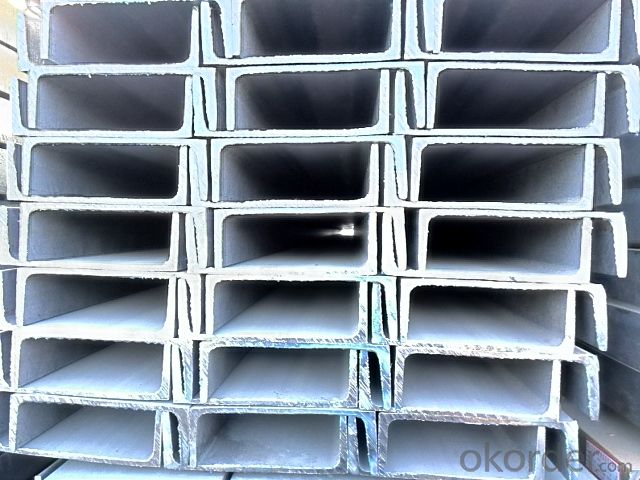
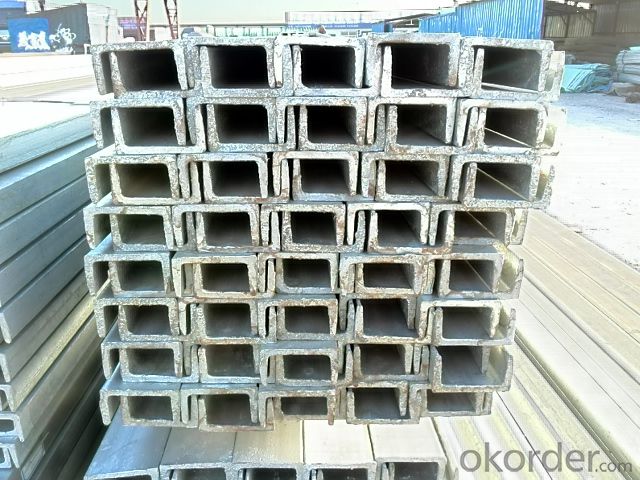
- Q: How do steel channels compare to other structural materials?
- Steel channels are widely regarded as one of the most versatile and reliable structural materials. They offer exceptional strength-to-weight ratio, making them highly efficient in load-bearing applications. Compared to other materials such as wood or concrete, steel channels are more durable, resistant to corrosion, and have superior fire resistance. Additionally, their uniformity and precision in manufacturing ensure consistent quality and ease of installation. Overall, steel channels outperform many other structural materials due to their exceptional strength, durability, and versatility.
- Q: Are steel channels suitable for modular partition systems?
- Yes, steel channels are suitable for modular partition systems. Steel channels are commonly used in construction for their strength and durability. They provide excellent support and stability for modular partition systems, ensuring that the partitions are secure and can withstand the weight and pressure exerted on them. The use of steel channels in modular partition systems also allows for flexibility and ease of installation. Steel channels can be easily cut and shaped to fit the desired dimensions and specifications of the partition system. This makes it convenient to customize the layout and design according to specific requirements. Additionally, steel channels offer a high level of fire resistance, which is crucial in ensuring the safety of occupants. In the event of a fire, steel channels can help prevent the spread of flames and smoke, providing valuable time for evacuation and minimizing damage. Furthermore, steel channels are corrosion-resistant, making them suitable for use in various environments, including high humidity areas such as kitchens and bathrooms. They are also relatively low maintenance, requiring minimal upkeep over time. In summary, steel channels are an excellent choice for modular partition systems due to their strength, durability, flexibility, fire resistance, and corrosion resistance. They provide a solid foundation for secure and long-lasting partitions, making them a reliable option for various applications.
- Q: What are the different methods for reinforcing steel channels against bending?
- There are various techniques available for strengthening steel channels against bending. 1. Additional steel plates can be utilized. One approach is to affix steel plates to both the upper and lower flanges of the channel. These plates can be welded or bolted to the existing flanges, thereby enhancing their strength and rigidity. This method is commonly employed when the channel is exposed to significant bending forces or when it needs to bear heavier loads. 2. Channel stiffeners can be employed. These are extra steel components that are attached either internally or externally to the channel to augment its strength and prevent bending. Usually, these stiffeners are welded or bolted to the flanges and web of the channel. They distribute the bending forces more evenly across the channel, thereby reducing the risk of failure. 3. Concrete reinforcement is another option. This involves reinforcing the steel channel with concrete. Typically, the channel is encased in a layer of concrete, which provides added strength and stiffness. The concrete can be poured around the channel or precast and subsequently attached to it. This method is commonly utilized in construction applications, such as bridges and buildings, where the channel needs to withstand high bending forces. 4. Composite materials can also be used for reinforcement. Materials like carbon fiber reinforced polymer (CFRP) can be employed to strengthen steel channels against bending. CFRP strips or sheets can be bonded to the flanges or web of the channel, delivering additional strength and rigidity. This method is lightweight and can be easily implemented in existing structures or during fabrication. It is important to consider various factors, including the magnitude of the bending forces, the specific application, and the available resources, when selecting a reinforcement method. Consulting with a structural engineer or an industry professional is advisable to determine the most suitable approach for a particular project.
- Q: How do steel channels contribute to the overall structural integrity of a building?
- The utilization of steel channels plays a pivotal role in augmenting the overall structural soundness of a building. These essential structural constituents are frequently employed in construction projects due to their exceptional robustness, endurance, and adaptability. Generally, steel channels are fashioned into C-shaped or U-shaped beams using steel, which confers numerous advantages for the structural stability of a building. Primarily, steel channels proficiently distribute and convey loads. As a result of their configuration, steel channels are adept at supporting heavy loads and evenly dispersing them across multiple points. This equitable allocation of weight obviates the occurrence of concentrated stress points, thereby mitigating the risk of structural failure. Additionally, steel channels possess a high load-bearing capacity, enabling them to endure substantial forces and guarantee the overall steadiness of the building. Secondarily, steel channels offer resistance against bending and torsion forces. Their shape and material composition empower them to resist deformation under pressure, guaranteeing that the building maintains its structural integrity even under extreme conditions such as earthquakes or strong winds. By averting excessive deflection, steel channels aid in maintaining the safety and security of the building. Moreover, steel channels boost the rigidity and stability of the structure. By connecting various components of the building, such as beams, columns, and walls, steel channels effectively eliminate any potential weak points or gaps. This comprehensive integration of different elements contributes to the overall strength and stability of the building, precluding any potential structural failures. Lastly, steel channels provide flexibility in design and construction. They can be easily customized to suit specific architectural requirements, allowing for innovative and efficient building designs. The versatility of steel channels empowers architects and engineers to optimize the strength and stability of the structure while preserving aesthetic appeal. In conclusion, steel channels play a significant role in bolstering the overall structural integrity of a building by efficiently distributing and conveying loads, resisting bending and torsion forces, enhancing rigidity and stability, and providing design flexibility. Their strength, durability, and versatility render them an indispensable component in contemporary construction, ensuring the safety and longevity of buildings.
- Q: How do steel channels perform in high-traffic areas?
- Steel channels perform well in high-traffic areas due to their durability and strength. These channels, also known as steel C-channels, are commonly used in construction and industrial projects to provide support and stability. Their robustness makes them highly resistant to damage from heavy loads, impacts, and constant foot traffic. In high-traffic areas such as walkways, bridges, and commercial spaces, steel channels offer several advantages. Firstly, they can handle significant weight without bending or warping, ensuring long-lasting performance even under intense pressure. This makes them ideal for supporting heavy machinery, vehicles, or large groups of people. Moreover, steel channels have excellent corrosion resistance, which is essential in high-traffic areas prone to moisture and other environmental factors. They can withstand exposure to rain, snow, and chemicals without deteriorating, making them suitable for outdoor applications. Additionally, steel channels provide stability and safety in high-traffic areas. Their rigid structure and precise dimensions allow for secure installation, reducing the risk of accidents or structural failures. This is crucial in places where public safety is a concern, such as airports, train stations, or sports arenas. Furthermore, steel channels can be easily customized to meet specific project requirements. They can be cut, drilled, or welded to fit unique dimensions or angles, allowing for versatile applications in diverse high-traffic settings. This adaptability makes them highly suitable for projects with complex design needs. In conclusion, steel channels are an excellent choice for high-traffic areas due to their durability, strength, corrosion resistance, stability, and customization options. They offer reliable support and long-lasting performance, making them a reliable solution for both indoor and outdoor applications in demanding environments.
- Q: Are steel channels suitable for use in electrical applications?
- Yes, steel channels are suitable for use in electrical applications. Steel channels provide excellent strength, durability, and conductivity, making them ideal for supporting and protecting electrical wiring and cables in various applications such as power distribution, control panels, and cable management systems. They can effectively withstand heavy loads, resist corrosion, and provide reliable grounding, making them a reliable choice for electrical installations.
- Q: Can steel channels be used for supporting exterior cladding systems?
- Yes, steel channels can be used for supporting exterior cladding systems. Steel channels are strong and durable, making them suitable for providing structural support to the cladding. They can be used to create a framework that holds the cladding in place, ensuring it is securely attached to the building's exterior. Steel channels also offer versatility in design and can be customized to meet specific project requirements. Additionally, steel is resistant to weathering and corrosion, making it a reliable choice for exterior applications where the cladding needs to withstand various environmental conditions. Overall, steel channels are a popular choice for supporting exterior cladding systems due to their strength, durability, and versatility.
- Q: How are steel channels transported and stored?
- Steel channels are typically transported using trucks or trains, with careful consideration given to weight distribution and secure packaging. Once at the storage facility, they are usually stored in racks or on shelves, taking into account their size and weight to ensure safe and efficient stacking.
- Q: What are the common methods of joining steel channels together?
- Common methods of joining steel channels together include welding, bolting, riveting, and using adhesive or epoxy. Welding is a popular method that involves melting the edges of the steel channels and fusing them together. Bolting involves connecting the channels using bolts and nuts. Riveting involves inserting rivets into pre-drilled holes and deforming them to hold the channels together. Adhesive or epoxy can also be used to bond the channels together, providing a strong and durable connection.
- Q: How are steel channels installed in construction projects?
- Steel channels are commonly used in construction projects for their structural strength and versatility. Installing steel channels involves several steps to ensure proper alignment and stability. First, the location and layout of the steel channels are determined according to the project specifications and structural design. This step involves careful planning and coordination between architects, engineers, and construction teams. Next, the designated areas for steel channel installation are prepared. This may involve clearing the site, leveling the ground, and providing a stable foundation. Any necessary excavation or backfilling is also done at this stage. Once the site is prepared, the steel channels are delivered to the construction site. They are typically pre-fabricated according to the required dimensions and specifications. The channels are then transported to the installation area using cranes or other lifting equipment. Before installing the steel channels, the construction team ensures that the channels are clean and free from any debris or contaminants. This is crucial to ensure proper bonding and stability during installation. The installation process begins by aligning the steel channels in the designated positions. This is done using laser levels, plumb bobs, or other alignment tools to ensure accurate placement. The channels are then temporarily secured in place using clamps or braces. To permanently fix the steel channels, welding or bolting methods are typically employed. Welding is a common technique used to join the channels to other structural elements. Skilled welders carefully weld the channels to the designated areas, ensuring strong and durable connections. In cases where welding is not feasible or desired, bolts or screws may be used to secure the steel channels. Holes are drilled through the channels and the corresponding structural elements, and bolts or screws are inserted and tightened to provide a secure connection. Throughout the installation process, quality control measures are implemented to ensure that the steel channels are installed correctly. This may involve inspections, measurements, and testing to verify alignment, levelness, and structural integrity. Once all the steel channels are installed, they are typically inspected for any defects or imperfections. If necessary, adjustments or repairs are made to ensure the channels meet the required standards and specifications. In conclusion, installing steel channels in construction projects involves careful planning, preparation, alignment, and secure attachment to other structural elements. Following proper installation procedures and quality control measures is essential to ensure the channels provide the necessary structural support and stability.
Send your message to us
JIS U Channels with High Quality and Competitive Price
- Loading Port:
- Tianjin
- Payment Terms:
- TT OR LC
- Min Order Qty:
- 25 m.t
- Supply Capability:
- 10000 m.t/month
OKorder Service Pledge
OKorder Financial Service
Similar products
Hot products
Hot Searches
Related keywords
